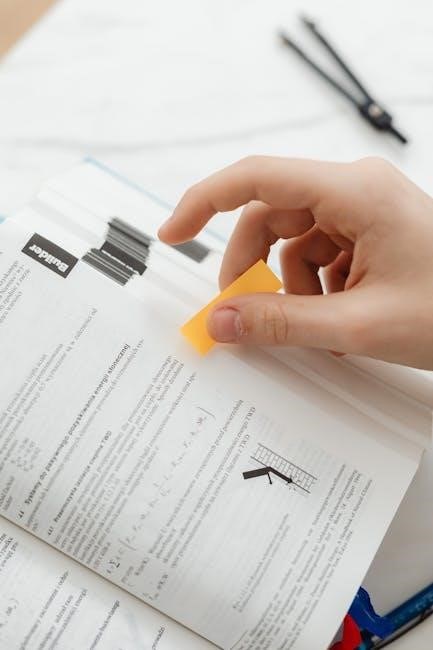
Referencing a user manual involves citing the corporate author, publication year, title, edition, and publisher. Include the URL if accessed online; Use in-text citations with the company name, year, and page number. Format the reference list entry with the company as the author, followed by the title, edition, publisher location, and publisher. Special cases include manuals with named authors or external publishers.

Identifying the Author
When referencing a user manual, the author is typically the corporate entity or organization that produced the manual. In APA style, the company name is listed as the author in the reference list. For example, if a manual is published by “MakerBot Industries,” the company name becomes the author. If the manual lists an individual author, such as “Bill Gates,” their name should be used instead. Always prioritize the name provided in the manual. If no author is listed, the corporate entity is considered the author. In in-text citations, the corporate name or individual author’s name is included in parentheses with the publication year. For example: (MakerBot Industries, 2014) or (Gates, 1995). This ensures proper attribution and clarity in academic or professional writing. The author’s identity is crucial for credibility, so it must be accurately identified and cited. If the manual is part of a product, the company’s name is still used as the author. This applies to both print and electronic manuals. Always check for any named authors first before defaulting to the corporate entity. If no author is provided, the corporate name is the best option. This ensures consistency in referencing user manuals across various formats and styles. Proper identification of the author is the first step in creating accurate citations.
Year of Publication
The year of publication is a critical element when referencing a user manual. It is typically found on the title page, copyright notice, or the last page of the manual. In APA style, the publication year is included in both the in-text citation and the reference list entry. If the manual does not provide a specific publication year, use the copyright year as a substitute. For example, if the manual is copyrighted in 2014, the year 2014 is used in the citation. If no year is provided, use “n.d.” (no date) in the citation. Always verify the manual for the most accurate publication date. The year is essential for proper citation, as it helps readers identify the edition and relevance of the information. In in-text citations, the year follows the author’s name in parentheses, such as (MakerBot Industries, 2014). For undated manuals, include “n.d.” in the citation, e.g., (MakerBot Industries, n.d.). This ensures clarity and academic integrity in your work. If the manual is part of a product, check the packaging or manufacturer’s website for the publication year. Accurate year citation is vital for credibility and proper referencing. Always prioritize the most specific and accurate date available. If unsure, consult additional resources or the publisher for clarification. Proper citation of the publication year ensures your work is well-documented and reliable.

Title and Edition

The title of the user manual should be included in the reference list entry, typically italicized and in sentence case. If the manual is a specific edition, the edition number should be noted in parentheses after the title. For example, “C1/C3 Lifecycle Exercise Bikes: Base User Manual (3rd ed.).” This provides clarity and ensures readers can locate the exact version referenced. The title should be descriptive and match the wording on the manual’s cover or title page. If the manual is part of a product package, include the product name in the title for better identification. In in-text citations, the title is not typically included unless it is part of a parenthetical citation. Always capitalize the main words in the title for consistency. If the manual is accessed online, the title should be followed by a URL or retrieval statement. Including the edition is crucial for manuals that are updated regularly, as it specifies which version was used. Properly formatting the title and edition ensures accuracy and helps avoid confusion, especially when multiple versions of the manual exist. This attention to detail supports academic integrity and clear communication in your work. Always verify the title and edition directly from the manual or its publisher to ensure correctness.
Publisher Information
Publisher information is essential when referencing a user manual, as it indicates the entity responsible for producing and distributing the document. In most cases, the publisher is the company or organization that manufactured the product or developed the system described in the manual. The publisher’s name should be included in the reference list entry, typically after the title and edition of the manual. For example, “MakerBot Industries” might be listed as the publisher for a user manual related to their products.

If the manual is published by an external entity rather than the product manufacturer, that publisher’s name should be used instead. The location of the publisher (e.g., city and state or country) is also included, especially for print manuals, to provide additional context. For online manuals, the publisher’s information is followed by the URL where the manual was retrieved. In in-text citations, the publisher’s name is not typically included unless it is part of the parenthetical citation. Always verify the publisher’s details directly from the manual or its official source to ensure accuracy. Properly citing the publisher helps maintain the credibility of your work and allows readers to trace the source of the information. This step is crucial for academic and professional integrity.
URL for Online Access

In-Text Citations
In-text citations for user manuals follow standard author-date citation formats, with the corporate entity serving as the author. When quoting or paraphrasing from the manual, include the company name, year of publication, and page number if applicable. For example, (Company Name, Year, p. Page Number). If the manual does not list an individual author, the company name is used as the author in both the in-text citation and the reference list. If the manual includes a specific author, their name is used instead of the company. When the citation is part of the sentence structure, only the year and page number are included in parentheses. For instance, Company Name (Year, p. Page Number). In cases where the page number is not available, as in electronic manuals, use the paragraph or section number if possible. Consistency in citation style is crucial, and all in-text citations must correspond to entries in the reference list. Proper in-text citations ensure academic integrity and allow readers to trace the source of information effectively. Always adhere to the specific citation style guidelines, such as APA, MLA, or Chicago, when formatting in-text citations for user manuals. This practice maintains clarity and professionalism in scholarly writing.
Formatting the Reference List
When formatting the reference list for a user manual, it is essential to include all necessary details to ensure clarity and proper citation. The reference list entry should begin with the company name, as it serves as the author of the manual. Following the company name, include the publication year in parentheses. The title of the manual should be italicized and capitalized, and if there is an edition number, it should be noted immediately after the title. Publisher information should then be provided, typically consisting of the company’s location and name. If the manual was accessed online, the URL must be included at the end of the entry. Proper punctuation and formatting, such as periods and commas, should be used to separate these elements. Consistency in formatting is crucial, and all entries should follow the same citation style guidelines, whether APA, MLA, or Chicago. Additionally, the reference list should be alphabetized, usually by the company name or, if unavailable, by the title of the manual. Ensuring that each entry is correctly formatted helps maintain academic integrity and allows readers to easily locate the source of the information.

Special Cases
There are several special cases to consider when referencing a user manual. If the manual lists an individual author, their name should be used in place of the company name in the reference list. For example, if the manual is authored by a person, the citation would follow the standard book format. Another special case arises when the manual is published by an external publisher rather than the company itself. In this scenario, the publisher’s name replaces the company information in the reference list. Additionally, if the manual is a second or subsequent edition, the edition number should be included in the title, such as “(2nd ed.).” For online manuals, the URL must be included at the end of the reference list entry to provide access to the source. When citing a manual without a clear author or publication date, the company name and title become the primary elements. In-text citations should still include the company name, year, and page number if applicable. These special cases ensure that all types of user manuals are properly cited, maintaining consistency and accuracy in academic and professional work. Proper citation also avoids plagiarism and gives credit to the original source.